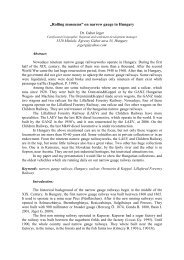'Representing Difficult Pasts within Complex Presents ... - T2M
'Representing Difficult Pasts within Complex Presents ... - T2M
'Representing Difficult Pasts within Complex Presents ... - T2M
Create successful ePaper yourself
Turn your PDF publications into a flip-book with our unique Google optimized e-Paper software.
ships models 33 , and there are apparently a great deal more in storage. There was also a small exhibition –<br />
‘The Last Voyage of the Mendi’ with video as well as text/photographic panels, depicting a shipwreck.<br />
The Slave Lodge, in Cape Town, is in the building constructed on the site of the original slave<br />
lodge in Cape Town 34 . The exhibition ‘Remembering Slavery’ was on the ground floor, a multimedia<br />
exhibition with thematic room installations, poetry and sound. The exhibition manager, Fiona Clayton<br />
claimed that the story of slave transportation depicted by the exhibition is overall a more general story of<br />
slavery, rather than one specific to the experience of travel by Cape Town slaves. An example is the<br />
inclusion of the archetypal picture of the specially-designed well-known ‘slave vessel’, despite the fact<br />
that slaves along the Dutch East India Company route were transported not separately, but as goods, with<br />
other ‘goods’ such as spices.<br />
24<br />
Figure 13. Slave trade, captured slaves 1861,<br />
displayed at The Slave Lodge<br />
In relation to the ‘act of looking’<br />
and representation <strong>within</strong> the museum<br />
context, the image of what was described as<br />
a ‘typical slave ship’ at the Slave Lodge<br />
suggests the Dias Museum image of a ship –<br />
displayed as an object in itself, of colonial<br />
celebration, travel and discovery, detached<br />
from the history of exploitation and slavery that followed it. An image of slaves being led in chains after<br />
capture at the Slave Lodge also depicts a different perspective to that of the Maritime museum’s story of<br />
maritime transportation, or maps of trade and discovery at the Dias Museum. The map depicting ship<br />
routes where slaves were taken from to Cape Town on display in the Slave Lodge, can be compared to the<br />
map of Spice Routes in the Dias Museum – two maps intrinsically related but existing <strong>within</strong> different<br />
contexts of interpretation.<br />
33<br />
The museum previously had a full-time model maker who apparently stayed very busy, and ship<br />
companies previously had ship models that were given to the museum.<br />
34<br />
The building, which originally housed slaves after arrival at the Cape, changed its official name from the<br />
Cultural History Museum to the Slave Lodge in 1998 and still houses many what are arguably colonial ‘cultural<br />
artefacts’ on its upper floor




